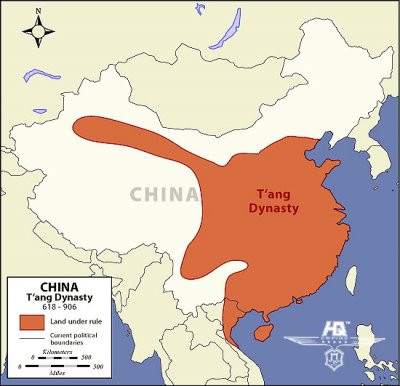Tang Dynasty Geography
 The Tang Dynasty was the longest enduring and second largest empire after the Han Empire. Created due to the rift left by the ruthless and brutal leadership of the Han Dynasty, the Tang Dynasty ushered in what most people consider to be China’s golden age.
The Tang Dynasty was the longest enduring and second largest empire after the Han Empire. Created due to the rift left by the ruthless and brutal leadership of the Han Dynasty, the Tang Dynasty ushered in what most people consider to be China’s golden age.
The Tang Dynasty mainly stretched from the Korean Peninsula to the Tarim Basin and from the Mongolian steppe south to modern Vietnam. The vast territory of the Tang Dynasty included the capital city of Chang’an, which is modern-day Xian. Tang Dynasty geography was well documented. At that time, Chang’an had several secondary capitals and was also considered the biggest city on earth.
Capitals of the Tang Dynasty
While the main capital of the Tang Dynasty was Chang’an, there were several other capitals as well. Hezhong was the central capital which is modern-day Yongji. Shanxi, now known as Luoyang, was the eastern capital, and it is still known as Luoyang, Henan of modern China.
Moreover, the modern-day city of Fengxiang, Shaanxi, was the western capital and is still known as Fengxiang today. The northern capital was known as Taiyuan which is modern city of Taiyuan, Shaanxi. Lastly, the southern capital was known as Chengdu, but was later changed to Jiangling. The southern capital is the modern-day Sichuan (Jiangling).
Circuit Divisions
Initially, the entire dynasty was divided into 10 circuits (Dao). However, this number was increased later to a total of 15 circuits. Eventually, these prefectural seats (circuits) included:
1. Jingji, which is in southern Shaanxi of the modern China
2. Guannei is located in the modern northern Shaanxi
3. Duji is the modern western Hinan
4. Henan is located in Shandong and Henan of the modern China
5. Hendong is located in the modern city of Shaanxi
6. Hebei is located in the modern cities of Beijing, Hebei, and Tianjin
7. Longyou is located at Ninxia and Gansu of modern China
8. Shannan-Dong is the modern-day Hubei
9. Shannan-Xi is located at Chongqing and Sichuan in modern China
10. Huainan is located across northern Anhuii and northern Jiangsu
11. Jiangnan-Dong spreads across southern Anhui, southern Jiangsu, Fujian, Shanghai, and Zhejiang
12. Jiangnan-Xi is located at eastern Hunan and also Jiangxi in modern China
13. Qianzhong is located at Guizhou and western Hunan
14. Jiannan is located in southern Sichuan
15. Lingnan spreads across Hainan, Guangdong, and Guangxi in the modern-day China
The Tang Dynasty geography was spread across much of what is China today. Moreover, it is considered a high point in the Chinese civilization.
